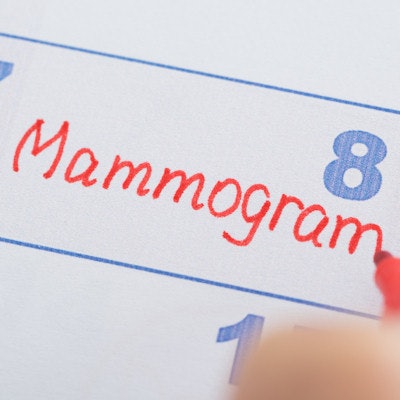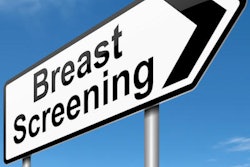
Skipping even one screening mammogram can increase a woman's risk of dying from breast cancer, according to a March 2 study involving more than half a million Swedish women. Conversely, more regular screening greatly reduces risk.
The study was led by mammography heavyweights Dr. László Tabár, a radiologist and oncologist from Falun Central Hospital in Falun, Sweden, and Stephen Duffy, a professor of cancer screening at Queen Mary University of London. The research team analyzed data from more than half a million women eligible for mammography screening in nine Swedish counties between 1992 and 2016.
The group found that women who attended two regularly scheduled mammography appointments before a cancer diagnosis had a 49% lower risk of breast cancer mortality and a 50% lower risk of breast cancer death within 10 years of diagnosis (Radiology, March 2, 2021).
"While we suspected that regular participation would confer a reduction greater than that with irregular participation, I think it is fair to say that we were slightly surprised by the size of the effect," Duffy said. "The findings support the hypothesis that regular attendance reduces the opportunity for the cancer to grow before it is detected."
Scientific literature has indicated that women with symptomatic breast cancers who have recently participated in screening have a survival advantage over women who have not. This is due in large part to the advantage of finding invasive cancers earlier, especially poorly differentiated tumors when they are smaller and have less node positivity.
The question is how much benefit does screening mammography confer? Does it matter whether women attend every appointment, or can they skip a few? That's what Duffy, Tabár, and colleagues set to find out.
The team sorted 549,091 women into the following four groups based on how frequently they kept their mammography appointments:
- Serial participants, who participated in the two most recent scheduled screening exams prior to cancer diagnosis
- Intermittent participants, who attended the last screening exam but not the penultimate one
- Lapsed participants, who attended the penultimate screening only
- Serial nonparticipants, who skipped both screening mammogram appointments
Serial participants had the highest mortality reduction at 49%, but women in the intermittent group had a mortality reduction of 33%, while lapsed participants had a mortality reduction of 28%. See the full results in the table below:
| Impact of screening mammography attendance on breast cancer mortality | ||||
| Serial participants | Intermittent participants | Lapsed participants | Nonparticipants | |
| Breast cancer mortality reduction | 49% | 33% | 28% | None |
| Incidence rate reduction of breast cancers fatal within 10 years | 50% | 36% | 25% | None |
"Our current study shows a greater mortality benefit for those attending two successive screening examinations than for those who attended only one examination," the researchers wrote. "[R]egular participation in screening mammography is necessary to optimize the reduction in risk of dying from breast cancer."
The research team plans to keep studying mammography data to develop a more comprehensive picture of screening benefits, including for cancers that develop in between screening exams, known as interval cancers.
"We are planning further prognostic research into the mechanism of this effect," Duffy said. "For example, we plan to investigate whether and -- if so -- to what extent regular attendance improves the prognosis of interval cancers as well as screen-detected cancers. Estimation of this by time since last screen may have implications for policy on screening frequency."



















